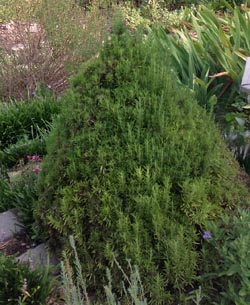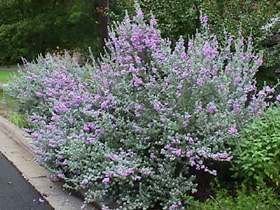Shrubs for Central Texas
Abelia: This is a graceful large shrub with arching branches and small white blooms throughout the year (whenever the shrub feels like it). It gets quite large and should not be trimmed into a hedge; that would ruin its form. Just trim to keep it from getting too large. Full sun, moderate water.
Aralia: This tropical looking shrub is really hardy here in Texas. It needs plenty of shade and moderate
watering. A particularly hard winter will kill it.
Artemisia: This is an herb, but it grows so large it needs to be classified
as a shrub. Since it grows large in just one season, it is a great plant to
use for quick shrubs wherever you need one. Nothing bothers this
plant, neither bug nor disease. You may need to cut it back so it does not
take over the whole bed. Plant in full sun to part shade and water
occasionally. Prune each spring to a few main stems to encourage bushiness.
Bridal wreath spirea: this is a graceful early spring blooming shrub. Its white flowers herald the beginning of spring time. It is a lovely companion to early blooming roses. Tough, disease resistant, it does not ask for much of anything from you.
Chinese Photinia: This large shrub can be trimmed up into a small decorative tree. These often grow wild in Texas; that shows how tough they are. It will bloom in the spring with large white blooms, followed by berries, which Cedar Waxwings love to eat. If they don't discover them, the berries will be a pretty winter accent to the garden. Plant anywhere; it thrives on neglect.
Crape mrytle: No list of ornamental trees and shrubs would be complete without mention of the Crape myrtle, star of the Texas landscape. The trick to having a healthy crape myrtle is planting it in full sun with good air circulation. It doesn't need a lot of water and it certainly doesn't need to be trimmed severely back. Never top a crape mrytle! Master gardeners swoon when they see this! Check out some of the smaller varieties that make good shrubs.
Hollies: There are many good varieties of hollies for Central Texas.
Some are small trees, some are large shrubs, and some are small shrubs like you
see in this picture, the Dwarf yaupon holly. You will need to decide what purpose for which you wish to use your
holly, in order to pick the right variety. This plant group is one of the very best for our area. They are all tough and
beautiful. Some have red berries, such as the possumhaw holly, which loses its leaves in the winter,
leaving its branches filled with pretty red berries. Some are evergreen, keeping their leaves all year round.
They come in various leaf shapes and sizes. Only the females have berries, so try to find a plant that has berries on it when
you buy it to be sure of what you are getting. Most hollies can take either full sun or even a lot of shade. They are drought tolerant. Hollies' scientific name is Ilex. Consult a good gardening
book for the many types available so you can make the right
choice. Be sure to include several of these in your landscape; you will not be sorry.
Ligustrum, variegated: This is a pretty bush will grow in part shade. It has small green leaves with cream colored variegation. Its natural graceful shape does not need to be pruned. It is drought tolerant.
Loropetalum: also called fringe flower, this is a maroon colored shrub with pink flowers. The regular sized ones get very big, as much as 12 feet tall by 8 feet wide. If you want a small shrub look for the dwarf varieties. Plant in full sun to partial shade.
Mexican feather grass: This is a lovely medium grass with very thin leaves that looks graceful in the garden when paired with other perennials. Plant in the fall or early spring. This plant does not like a lot of water so water only in drought conditions. It will look like it is dead in the middle of summer, but this is natural and not unattractive.
Nandina: Nandinas also will grow in the wild here. They are beautiful shrubs with red berries and pretty leaves. They come in several sizes; the larger ones are the best in appearance. It would be hard to kill this plant. Nandina likes some shade to be its best, but it will grow anywhere, with very little care or water. The picture shows snow on nandinas in January. CAUTION: NANDINAS ARE INVASIVE.
 Rosemary: Though rosemary is an herb the
upright varieties make great shrubs. Rosemary has earned
the Earth-Kind ® designation. If you want to shape your rosemary plants, start training
them by careful pruning from the first day you have them. Never cut off large
amounts of any shrub all at once. It will look terrible and harm the shrub.
Rosemary: Though rosemary is an herb the
upright varieties make great shrubs. Rosemary has earned
the Earth-Kind ® designation. If you want to shape your rosemary plants, start training
them by careful pruning from the first day you have them. Never cut off large
amounts of any shrub all at once. It will look terrible and harm the shrub.
Santolina: this was the first plant I ever fell in love with. My aunt had one in her yard. Gray Santolina, the most common variety is the most vigorous. It forms a naturally mounded shape of dense gray foliage that smells heavenly. It takes full sun and does not need supplemental irrigation unless we have two months of drought with over 100° weather. There is also a green Santolina that is nice but it is not as vigorous.
 Texas Sage: This wonderful large shrub is gray with lavendar flowers that cover
it sporadically from mid-summer until late
fall. It is a drought tolerant shrub suitable for hot, dry, well-drained soil with plenty of sun. Great for our climate; don't
overwater.
Texas Sage: This wonderful large shrub is gray with lavendar flowers that cover
it sporadically from mid-summer until late
fall. It is a drought tolerant shrub suitable for hot, dry, well-drained soil with plenty of sun. Great for our climate; don't
overwater.
 Vitex: this wonderful small tree has beautiful flower
spikes that are bluish purple. It is drought tolerant and usually does not succumb to pests or
heat. You can keep this shrub any size you want. You can cut it down to the
ground so that it will stay a small shrub, or you can let it grow naturally
as a large shrub. You can remove the lower branches to make it look more
like a tree if you wish. This plant has earned the distinguished designation
of a Texas Superstar plant. It attracts butterflies. Click on the thumbnail
for a closer look.
Vitex: this wonderful small tree has beautiful flower
spikes that are bluish purple. It is drought tolerant and usually does not succumb to pests or
heat. You can keep this shrub any size you want. You can cut it down to the
ground so that it will stay a small shrub, or you can let it grow naturally
as a large shrub. You can remove the lower branches to make it look more
like a tree if you wish. This plant has earned the distinguished designation
of a Texas Superstar plant. It attracts butterflies. Click on the thumbnail
for a closer look.
Wax myrtle: this is an attractive evergreen shrub that can grow well in the shade, although it can take full sun. Choose a variety by its mature height, as there are very short ones and some that grow even taller than 20 feet.
Yucca: This plant is as tough as they come. About the only way you can kill it is by overwatering. This is a good choice for hot dry areas. Red yuccas grow lovely red flower spikes.
